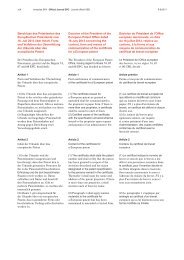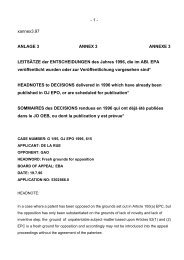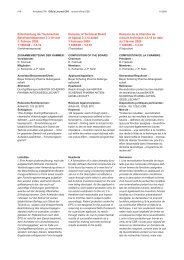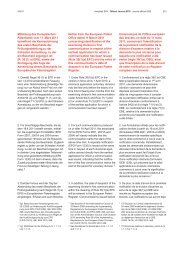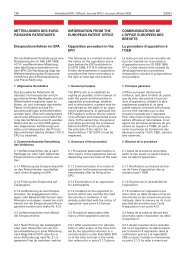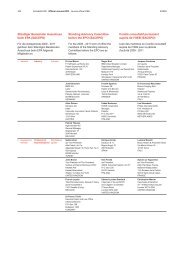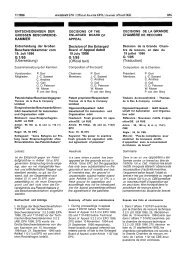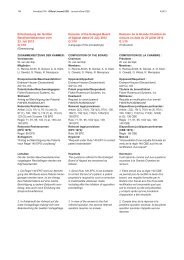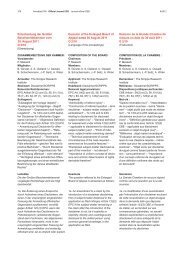Sonderausgabe 1 - European Patent Office
Sonderausgabe 1 - European Patent Office
Sonderausgabe 1 - European Patent Office
Create successful ePaper yourself
Turn your PDF publications into a flip-book with our unique Google optimized e-Paper software.
2007 <strong>Sonderausgabe</strong> Nr. 1 ABl. EPA / Special edition No. 1 OJ EPO / Edition spéciale n° 1 JO OEB 119<br />
(2) Ein nach dem Anmeldetag eingereichtes<br />
Sequenzprotokoll ist nicht<br />
Bestandteil der Beschreibung.<br />
(3) Hat der Anmelder nicht bis zum<br />
Anmeldetag ein den Erfordernissen des<br />
Absatzes 1 entsprechendes Sequenzprotokoll<br />
eingereicht, so fordert ihn das<br />
Europäische <strong>Patent</strong>amt auf, ein solches<br />
Sequenzprotokoll nachzureichen und die<br />
Gebühr für verspätete Einreichung zu<br />
entrichten. Reicht der Anmelder das<br />
erforderliche Sequenzprotokoll nicht<br />
innerhalb von zwei Monaten nach dieser<br />
Aufforderung unter Entrichtung der<br />
Gebühr für verspätete Einreichung nach,<br />
so wird die Anmeldung zurückgewiesen.<br />
Regel 31<br />
Hinterlegung von biologischem Material<br />
(1) Wird bei einer Erfindung biologisches<br />
Material verwendet oder bezieht sie sich<br />
auf biologisches Material, das der<br />
Öffentlichkeit nicht zugänglich ist und in<br />
der europäischen <strong>Patent</strong>anmeldung<br />
nicht so beschrieben werden kann, dass<br />
ein Fachmann die Erfindung danach<br />
ausführen kann, so gilt die Erfindung nur<br />
dann als gemäß Artikel 83 offenbart,<br />
wenn<br />
a) eine Probe des biologischen Materials<br />
spätestens am Anmeldetag bei einer<br />
anerkannten Hinterlegungsstelle unter<br />
denselben Bedingungen wie denen des<br />
Budapester Vertrags über die internationale<br />
Anerkennung der Hinterlegung von<br />
Mikroorganismen für die Zwecke von<br />
<strong>Patent</strong>verfahren vom 28. April 1977<br />
hinterlegt worden ist,<br />
b) die Anmeldung in der ursprünglich<br />
eingereichten Fassung die dem<br />
Anmelder zur Verfügung stehenden<br />
maßgeblichen Angaben über die Merkmale<br />
des biologischen Materials enthält,<br />
c) die Hinterlegungsstelle und die<br />
Eingangsnummer des hinterlegten biologischen<br />
Materials in der Anmeldung<br />
angegeben sind und<br />
d) – falls das biologische Material nicht<br />
vom Anmelder hinterlegt wurde – Name<br />
und Anschrift des Hinterlegers in der<br />
Anmeldung angegeben sind und dem<br />
Europäischen <strong>Patent</strong>amt durch Vorlage<br />
von Urkunden nachgewiesen wird, dass<br />
der Hinterleger den Anmelder ermächtigt<br />
hat, in der Anmeldung auf das hinterlegte<br />
biologische Material Bezug zu<br />
nehmen, und vorbehaltlos und unwiderruflich<br />
seine Zustimmung erteilt hat, dass<br />
das von ihm hinterlegte Material nach<br />
Maßgabe der Regel 33 der Öffentlichkeit<br />
zugänglich gemacht wird.<br />
(2) A sequence listing filed after the<br />
date of filing shall not form part of the<br />
description.<br />
(3) Where the applicant has not filed a<br />
sequence listing complying with the<br />
requirements under paragraph 1 at the<br />
date of filing, the <strong>European</strong> <strong>Patent</strong> <strong>Office</strong><br />
shall invite the applicant to furnish such<br />
a sequence listing and pay the late<br />
furnishing fee. If the applicant does not<br />
furnish the required sequence listing and<br />
pay the required late furnishing fee<br />
within a period of two months after such<br />
an invitation, the application shall be<br />
refused.<br />
Rule 31<br />
Deposit of biological material<br />
(1) If an invention involves the use of or<br />
concerns biological material which is not<br />
available to the public and which cannot<br />
be described in the <strong>European</strong> patent<br />
application in such a manner as to<br />
enable the invention to be carried out by<br />
a person skilled in the art, the invention<br />
shall only be regarded as being<br />
disclosed as prescribed in Article 83 if:<br />
(a) a sample of the biological material<br />
has been deposited with a recognised<br />
depositary institution on the same terms<br />
as those laid down in the Budapest<br />
Treaty on the International Recognition<br />
of the Deposit of Microorganisms for<br />
the Purposes of <strong>Patent</strong> Procedure of<br />
28 April 1977 not later than the date of<br />
filing of the application;<br />
(b) the application as filed gives such<br />
relevant information as is available to the<br />
applicant on the characteristics of the<br />
biological material;<br />
(c) the depositary institution and the<br />
accession number of the deposited<br />
biological material are stated in the application,<br />
and<br />
(d) where the biological material has<br />
been deposited by a person other than<br />
the applicant, the name and address of<br />
the depositor are stated in the application<br />
and a document is submitted to<br />
the <strong>European</strong> <strong>Patent</strong> <strong>Office</strong> providing<br />
evidence that the depositor has<br />
authorised the applicant to refer to the<br />
deposited biological material in the<br />
application and has given his unreserved<br />
and irrevocable consent to the deposited<br />
material being made available to the<br />
public in accordance with Rule 33.<br />
(2) Un listage de séquences produit<br />
après la date de dépôt ne fait pas partie<br />
de la description.<br />
(3) Si, à la date de dépôt, le demandeur<br />
n’a pas produit un listage de séquences<br />
établi conformément aux exigences<br />
prévues au paragraphe 1, l’<strong>Office</strong> européen<br />
des brevets invite le demandeur à<br />
fournir ce listage de séquences et à<br />
acquitter la taxe pour remise tardive. Si<br />
le demandeur ne fournit pas le listage de<br />
séquences requis et n’acquitte pas la<br />
taxe pour remise tardive dans un délai<br />
de deux mois à compter de cette invitation,<br />
la demande est rejetée.<br />
Règle 31<br />
Dépôt de matière biologique<br />
(1) Lorsqu’une invention comporte l’utilisation<br />
d’une matière biologique ou<br />
qu’elle concerne une matière biologique<br />
à laquelle le public n’a pas accès et qui<br />
ne peut être décrite dans la demande de<br />
brevet européen de façon à permettre à<br />
un homme du métier d’exécuter l’invention,<br />
celleci n’est considérée comme<br />
exposée conformément à l’article 83<br />
que si :<br />
a) un échantillon de la matière biologique<br />
a été déposé auprès d’une autorité<br />
de dépôt habilitée, dans les mêmes<br />
conditions que celles prévues par le<br />
Traité de Budapest sur la reconnaissance<br />
internationale du dépôt des microorganismes<br />
aux fins de la procédure en<br />
matière de brevets du 28 avril 1977, au<br />
plus tard à la date de dépôt de la<br />
demande ;<br />
b) la demande telle que déposée<br />
contient les informations pertinentes<br />
dont dispose le demandeur sur les<br />
caractéristiques de la matière biologique<br />
;<br />
c) la demande comporte l’indication de<br />
l’autorité de dépôt et le numéro d’ordre<br />
de la matière biologique déposée, et<br />
d) lorsque la matière biologique a été<br />
déposée par une personne autre que le<br />
demandeur, le nom et l’adresse du déposant<br />
sont mentionnés dans la demande<br />
et il est fourni à l’<strong>Office</strong> européen des<br />
brevets un document prouvant que le<br />
déposant a autorisé le demandeur à se<br />
référer dans la demande à la matière<br />
biologique déposée et a consenti sans<br />
réserve et de manière irrévocable à<br />
mettre la matière déposée à la disposition<br />
du public, conformément à la<br />
règle 33.



